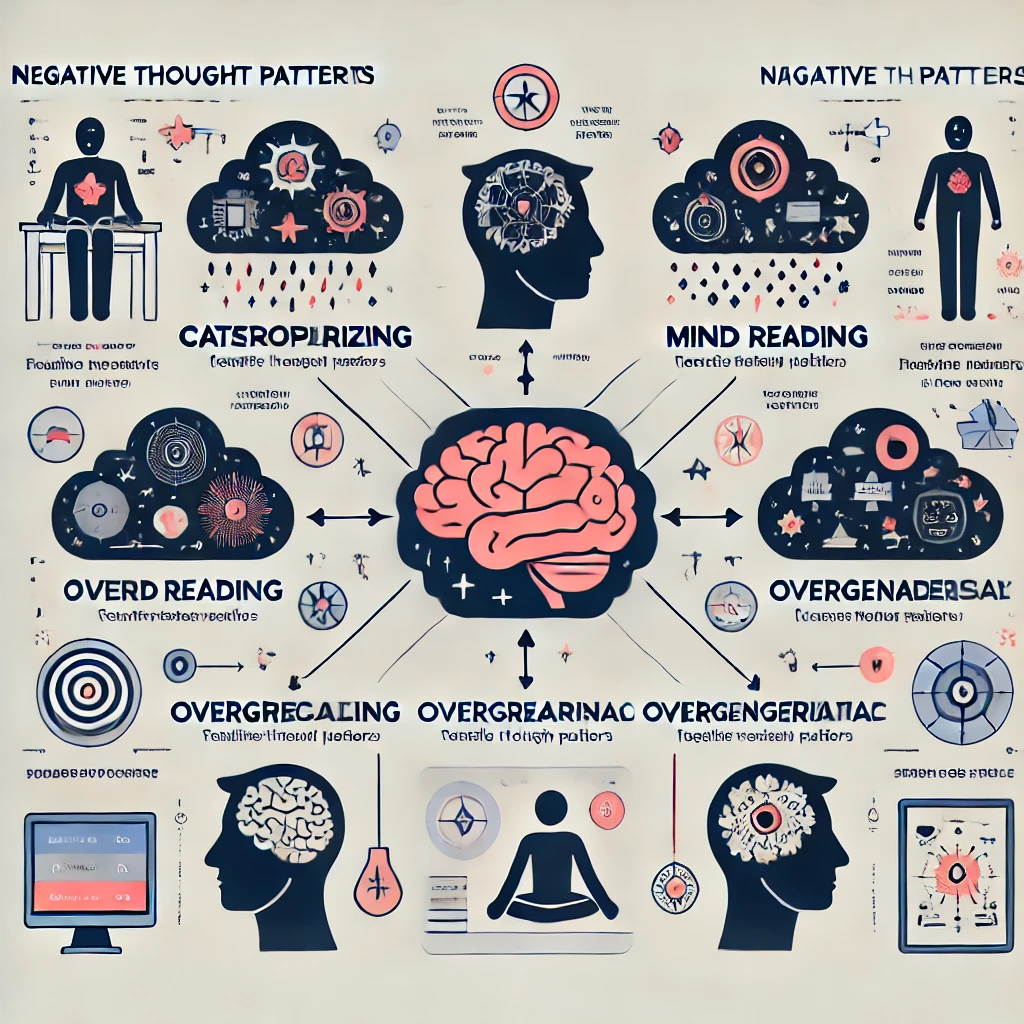
Negative thinking can feel like a constant cloud over your head, draining energy and affecting every aspect of your life. However, with the right understanding and tools, you can reframe your mindset and cultivate positivity. In this guide, we’ll explore the roots of negative thinking, how it impacts your life, and practical strategies to overcome it, supported by case studies and infographics
What is Negative Thinking?
Negative thinking involves a habit of focusing on flaws, failures, and potential disasters. It distorts your perspective, often leading to anxiety, self-doubt, and stress.
Personal Scenario:
“I’m constantly thinking, ‘What if everything goes wrong?’ It’s exhausting and makes it hard to focus on anything positive. Even when I achieve something, I feel like it’s not enough.”
Common Types of Negative Thinking Patterns
Below is a breakdown of common negative thinking patterns, along with scenarios that may feel familiar:

| Negative Thinking Pattern | Description | Personal Experience |
|---|---|---|
| Catastrophizing | Imagining the worst-case scenario in every situation. | “I accidentally sent an email with a typo. Now everyone must think I’m incompetent.” |
| All-or-Nothing Thinking | Viewing situations in extremes without middle ground. | “If I don’t excel in this project, I’m a complete failure.” |
| Overgeneralization | Drawing broad conclusions from a single event. | “I was rejected from one job. I’ll never get hired anywhere else.” |
| Mind Reading | Assuming you know what others are thinking, often negatively. | “My friend didn’t reply to my text right away. They must be mad at me.” |
| Self-Blame | Taking full responsibility for negative outcomes beyond your control. | “The group presentation went poorly, and it’s all my fault, even though others didn’t do their part.” |
Infographic: Negative Thinking Cycle
[Visual: A simple circular chart demonstrating the cycle of negative thinking]
- Trigger: A situation or event (e.g., a mistake at work).
- Negative Thought: “I’m not good enough.”
- Emotional Impact: Anxiety, stress, or low self-esteem.
- Behavioral Response: Avoidance, procrastination, or lashing out.
- Reinforcement: The belief grows stronger, creating a loop.
How Does Negative Thinking Feel?
- “I’m going through this right now…”
- “Every time I try something new, I hear this voice in my head saying, ‘You’re going to fail.’ It stops me from even trying.”
- “This sounds like me…”
- “When things go wrong, I immediately think it’s all my fault. Even if it’s beyond my control, I feel like I should have done better.”
- “I can relate to this scenario…”
- “I got into an argument with my friend, and now I’m convinced they don’t like me anymore. I’m overthinking every little thing I said.”
Why Does Negative Thinking Happen?
Infographic: Causes of Negative Thinking
- Past Experiences: Trauma, failure, or criticism in childhood.
- Environment: Pessimistic surroundings or toxic relationships.
- Biological Factors: Imbalances in brain chemicals like serotonin or dopamine.
- Cognitive Biases: Natural tendencies to focus on threats rather than opportunities.
Real-Life Case Studies
Case Study 1: Sarah’s Fear of Failure
- Background: Sarah, a young professional, avoids speaking up in meetings because she thinks her ideas aren’t good enough.
- Thoughts: “If I say something wrong, everyone will think I’m stupid.”
- Outcome: She misses chances to showcase her creativity.
- Solution: Sarah starts challenging her thoughts by asking, “What evidence do I have that this is true?” Over time, she realizes her fears are unfounded.
Case Study 2: Jack’s Procrastination Cycle
- Background: Jack constantly puts off important tasks because he feels overwhelmed by the possibility of failure.
- Thoughts: “I’ll never get this right, so why even try?”
- Outcome: His procrastination reinforces his belief that he’s incapable.
- Solution: Jack adopts the 2-Minute Rule from Atomic Habits—starting tasks for just two minutes to build momentum.
Infographic: Impact of Negative Thinking on Life

| Area of Life | Effect of Negative Thinking |
|---|---|
| Mental Health | Increased anxiety, depression, and chronic stress. |
| Relationships | Creates misunderstandings and emotional distance. |
| Career | Procrastination and self-doubt hinder productivity and growth. |
| Physical Health | Chronic stress can lead to fatigue, insomnia, and weakened immunity. |
Practical Strategies to Overcome Negative Thinking
1. Practice Gratitude
Focus on the positives in your life to counterbalance negativity.
- Actionable Tip: Keep a gratitude journal to list 3 positive moments each day.
- Scenario: “At first, it felt silly, but now I look forward to writing about small wins, like enjoying my coffee or a kind word from a coworker.”
2. Reframe Negative Thoughts
Challenge irrational beliefs by asking questions like:
- “Is this thought based on facts or feelings?”
- “What’s the worst-case scenario, and how likely is it?”
3. Try Guided Meditation
Mindfulness helps quiet the inner critic and centers your thoughts.
- Scenario: “I use a meditation app for 5 minutes every morning. It helps me stay calm and focused throughout the day.”
4. Cognitive Behavioral Techniques (CBT)
CBT helps you identify and replace distorted thinking.
- Scenario: “In therapy, I learned to notice when I’m catastrophizing and write down alternative explanations for what might happen.”
5. Build Positive Habits
Start small and celebrate every step.
- Example: Following Atomic Habits by James Clear, focus on creating systems rather than chasing goals.
Infographic: Steps to Rewire Your Mind
[Visual: A step-by-step process]
- Notice: Catch the negative thought.
- Pause: Take a deep breath to avoid reacting emotionally.
- Question: Is this thought true?
- Replace: Find a positive or neutral alternative.
- Act: Take a small, positive action to break the cycle.
Amazon Affiliate Recommendations
| Resource | How It Helps | Amazon Link |
|---|---|---|
| “Atomic Habits” by James Clear | Provides practical tips for building positive habits. | Buy on Amazon |
| Gratitude Journal | Helps track daily gratitude to reframe your mindset. | Buy on Amazon |
| “The Happiness Advantage” | Offers tools to harness positivity for personal and professional success. | Buy on Amazon |
| Affirmation Cards | Daily reminders to promote positive thinking. | Buy on Amazon |
| Meditation App Subscription | Guided meditations to reduce stress and reframe thoughts. | Find on Amazon |
Final Thoughts
Negative thinking is a habit—but like any habit, it can be changed. Start small by challenging one thought or celebrating one win daily. Over time, these small steps add up to a more positive and empowered mindset.
Call to Action:
What negative thought will you challenge today? Write it down, reframe it, and take the first step toward rewiring your mind!
Frequently Asked Questions About Negative Thinking?
1. Why do I always expect the worst in life?
Negative thinking, like expecting the worst, often stems from:
- Past Failures: Repeated negative outcomes reinforce a pessimistic mindset.
- Cognitive Bias: Your brain naturally over-focuses on potential threats as a survival instinct.
- Lack of Confidence: Doubts about your abilities can make even minor challenges feel insurmountable.
- Stress or Anxiety: These mental health issues fuel catastrophic thoughts.
Solution: Challenge your assumptions by asking, “What evidence do I have that the worst will happen?” and focus on past successes to build confidence.
2. How do I stop myself from overthinking everything?
To stop overthinking:
- Limit Decision Time: Set a timer for small decisions.
- Write Down Thoughts: Journaling can help you unload and organize your thoughts.
- Focus on Action: Instead of dwelling on “what-ifs,” take a small, positive step.
- Practice Mindfulness: Stay grounded in the present by using breathing exercises or meditation.
Example: “I used to overthink my emails. Now, I proofread them once, send them, and remind myself that most people won’t notice minor details.”
3. What are the most common negative thought patterns?
Negative thinking patterns include:
- Catastrophizing: Imagining worst-case scenarios, e.g., “If I make a mistake, my career is over.”
- Overgeneralization: Drawing broad conclusions, e.g., “I failed once, so I’ll always fail.”
- Mind Reading: Assuming others think badly of you, e.g., “They didn’t smile, so they must dislike me.”
- Black-and-White Thinking: Seeing situations in extremes, e.g., “If this isn’t perfect, it’s a failure.”
Recognizing these patterns is the first step to replacing them with more balanced thoughts.
4. What is the impact of negative thinking on daily life?
Negative thinking impacts every area of life, including:
- Mental Health: Leads to anxiety, depression, and low self-esteem.
- Physical Health: Prolonged stress can weaken your immune system and increase fatigue.
- Relationships: Creates misunderstandings or emotional distance.
- Career: Self-doubt and procrastination hinder productivity.
Breaking free from these thoughts improves emotional well-being and strengthens personal and professional growth.
5. How does gratitude help combat negative thinking?
Gratitude shifts focus from problems to positive aspects of life by:
- Rewiring Your Brain: Regular gratitude practices build neural pathways for positivity.
- Reducing Stress: Focusing on blessings lowers cortisol levels.
- Boosting Mood: Acts as a natural antidote to negativity by promoting feelings of contentment.
Tip: Start a daily gratitude journal. Write down three things you’re thankful for every night.
6. Can negative thinking be passed down from family?
Yes, negative thinking can develop through:
- Learned Behaviors: Growing up in a critical or pessimistic environment shapes your thought patterns.
- Genetic Factors: Family history of anxiety or depression may predispose you to negative thinking.
However, this doesn’t mean you’re stuck with it. Awareness and positive habits can help rewire your thinking.
7. What is the most effective habit to overcome negative thinking?
One of the most effective habits is practicing cognitive reframing:
- Notice the negative thought.
- Pause and ask, “Is this thought helping me?”
- Replace it with a neutral or positive alternative.
Example: Instead of thinking, “I’ll fail this project,” replace it with, “I’ve handled tough tasks before, and I’ll do my best with this one.”
8. How does mindfulness reduce negative thinking?
Mindfulness reduces negative thinking by:
- Focusing on the Present: Stops rumination about the past or future.
- Improving Emotional Regulation: Helps you respond thoughtfully instead of reacting impulsively.
- Building Awareness: Recognizing thought patterns before they spiral into negativity.
Example: Spend 5 minutes daily focusing on your breath. When your mind wanders to negative thoughts, gently bring it back to your breath.
9. How do positive affirmations help in rewiring the brain?
Positive affirmations help by:
- Replacing Negative Scripts: Transforming self-critical thoughts into empowering statements.
- Strengthening Neural Pathways: Repetition builds brain connections focused on positivity.
- Boosting Confidence: Helps shift self-perception over time.
Example: Instead of saying, “I’m terrible at public speaking,” repeat, “I’m improving every time I practice.”
10. What are some books to help overcome negative thinking?
Books that offer strategies for defeating negative thinking include:
- Atomic Habits by James Clear: Teaches small, consistent steps to build positive habits.
- The Happiness Advantage by Shawn Achor: Focuses on the power of positivity for success.
- The Power of Now by Eckhart Tolle: Guides readers on staying present to avoid overthinking.
These books provide actionable techniques for rewiring your mindset.